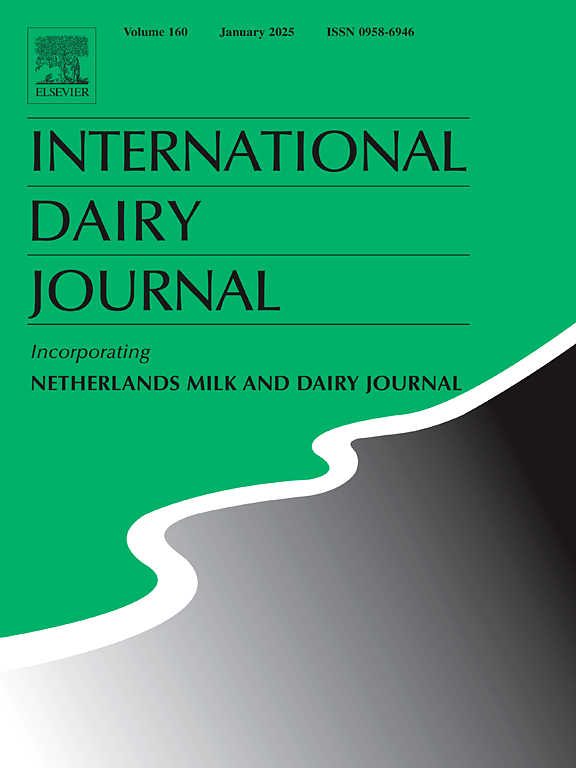The effect of shear stress on bovine lactoferrin
IF 3.4
3区 农林科学
Q2 FOOD SCIENCE & TECHNOLOGY
引用次数: 0
Abstract
Bovine lactoferrin is a multi-functional glycoprotein susceptible to environmental changes which can alter its structure and functionality. This paper explores the impact of shear stress on this protein in the presence of an air interface. Lactoferrin remained stable in 10 mM buffer when sheared at 4000 s−1 for 1h, while aggregate size increased from 13 to 405 nm in de-ionized water. The thermal stability of this latter sample also declined, with solution turbidity increasing after heating for 10 min at 80oC. This increased protein association could be related to higher surface hydrophobicity in de-ionized water. The iron-binding capacity of lactoferrin did not vary with shear stress but was notably higher in de-ionized water at pH 5.5 and buffer at pH 7. The study also compared UV absorbance, the Bradford Assay, and an Index of Refraction sensor for measuring protein concentration in turbid solutions, with the sensor proving the most effective.
剪切应力对牛乳铁蛋白的影响
牛乳铁蛋白是一种多功能糖蛋白,其结构和功能易受环境变化的影响。本文探讨了在空气界面存在的情况下剪切应力对这种蛋白质的影响。在4000 s−1下剪切1小时,乳铁蛋白在10 mM缓冲液中保持稳定,而在去离子水中团聚体尺寸从13 nm增加到405 nm。后一种样品的热稳定性也下降,在80℃下加热10 min后,溶液浊度增加。这种增加的蛋白质关联可能与去离子水中更高的表面疏水性有关。乳铁蛋白的铁结合能力不随剪切应力的变化而变化,但在pH为5.5的去离子水和pH为7的缓冲液中,其铁结合能力明显提高。该研究还比较了用于测量混浊溶液中蛋白质浓度的UV吸光度、Bradford Assay和折射率传感器,其中传感器被证明是最有效的。
本文章由计算机程序翻译,如有差异,请以英文原文为准。
求助全文
约1分钟内获得全文
求助全文
来源期刊

International Dairy Journal
工程技术-食品科技
CiteScore
6.50
自引率
9.70%
发文量
200
审稿时长
49 days
期刊介绍:
The International Dairy Journal publishes significant advancements in dairy science and technology in the form of research articles and critical reviews that are of relevance to the broader international dairy community. Within this scope, research on the science and technology of milk and dairy products and the nutritional and health aspects of dairy foods are included; the journal pays particular attention to applied research and its interface with the dairy industry.
The journal''s coverage includes the following, where directly applicable to dairy science and technology:
• Chemistry and physico-chemical properties of milk constituents
• Microbiology, food safety, enzymology, biotechnology
• Processing and engineering
• Emulsion science, food structure, and texture
• Raw material quality and effect on relevant products
• Flavour and off-flavour development
• Technological functionality and applications of dairy ingredients
• Sensory and consumer sciences
• Nutrition and substantiation of human health implications of milk components or dairy products
International Dairy Journal does not publish papers related to milk production, animal health and other aspects of on-farm milk production unless there is a clear relationship to dairy technology, human health or final product quality.
 求助内容:
求助内容: 应助结果提醒方式:
应助结果提醒方式:


